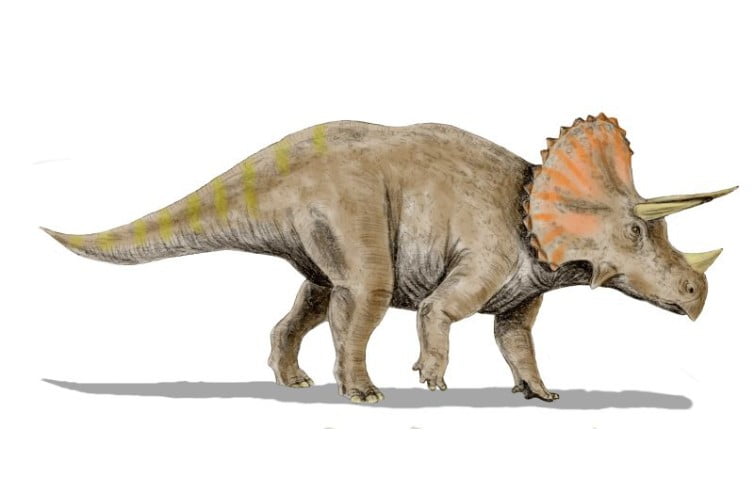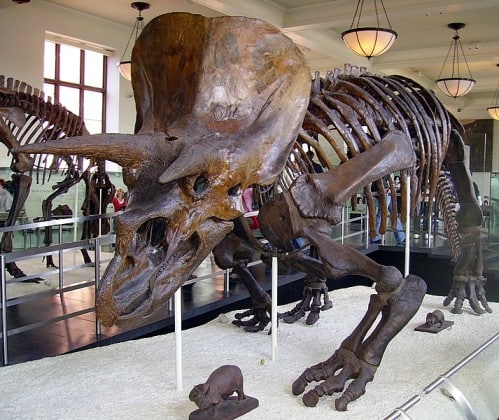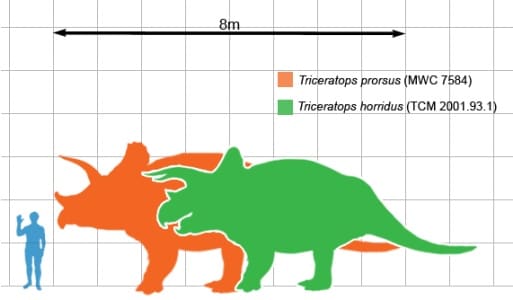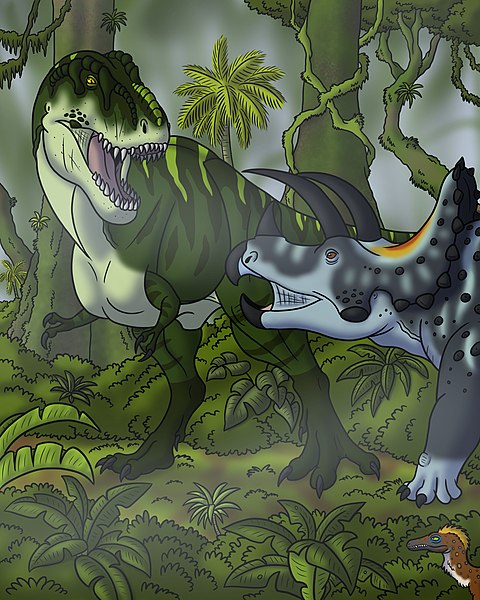The iconic Triceratops is easily recognized by its distinctive three-horned face and massive frill. It is a symbol of a time long past, a time when these magnificent beasts roamed the earth. The name translates to ‘three-horned face’, accurately conveying the diversity and grandeur of life during the Late Cretaceous period.
The Triceratops is more than just a symbol, however. It is a window into a world that has long since disappeared–a world that we can only begin to understand through the fossilized remnants these creatures left behind. We can piece together the story of this dinosaur through the study of its fossils in order to reveal its origins, taxonomy, size, appearance, and behavior.
Key Facts
| Keyword | Fact |
|---|---|
| Triceratops pronunciation | tri-SER-a-tops |
| Meaning of name | Three-horned face |
| Group | Ceratopsians |
| Type Species | Ceratops horridus |
| Diet | Herbivore |
| When it Lived | 72.1 to 66.0 MYA |
| Period | Late Cretaceous |
| Epoch | Maastrichtian to Lancian |
| Length | 30.0 ft |
| Height | 10.2 ft |
| Weight | 6.0 to 8.0 tons |
| Mobility | Moved on all four |
| First Discovery | 1887 by Othniel Charles Marsh |
| Location of first find | Denver, Colorado, USA |
| Also found in | Western North America |
| Described by | 1889 by Othniel Charles Marsh |
| Holotype | YPM 1820 |
Triceratops Origins, Taxonomy and Timeline

The name Triceratops is derived from the Greek words “tri” meaning three, “kera” meaning horn, and “ops” meaning face. This aptly describes this dinosaur’s most distinctive feature–its three-horned face. It belongs to the Ceratopsians group, a family of herbivorous dinosaurs known for their beaked faces and frilled neck shields.
This herbivore lived during the Late Cretaceous period. This was a time of significant change, with the continents drifting apart and the climate becoming more diverse. The Triceratops, with its robust physique and adaptability, thrived during this period and left behind a rich fossil record that continues to fascinate paleontologists today.
Listen to Pronunciation
Discovery & Fossil Evidence
The tale of its discovery is as fascinating as the dinosaur itself. It all began in 1887 when Othniel Charles Marsh, a pioneer in American paleontology, stumbled upon the first Triceratops fossil near Denver, Colorado. This marked the beginning of our understanding of this magnificent creature.

Since that initial discovery, the Triceratops has left a substantial fossil record across Western North America. These fossils range from skulls and teeth to limb bones and have provided a wealth of information, allowing us to piece together the physical characteristics and lifestyle of this dinosaur. Each new find adds another piece to the puzzle that helps us to better understand this iconic dinosaur.
The fossils not only tell us about its physical attributes but also offer insights into its behavior, diet, and environment. They are a testament to its existence, a tangible link to a world that existed millions of years ago. Through these fossils, the Triceratops continues to live on and captivate those that study it.
Triceratops Size and Description
This was a formidable dinosaur known for its large size and distinctive physical features. Its most notable characteristic was its large skull, adorned with three prominent horns and a large frill extending from the back of its skull. This combination of frill and horns gave the Triceratops its distinct appearance, likely used for both defense and display.
Short description of Triceratops
This was not just another dinosaur. It was a marvel of evolution, a creature perfectly adapted to its environment and lifestyle. Its unique features, from its three-horned face to its massive frill, were not just for show–they were functional adaptations that helped it survive in the harsh world of the Late Cretaceous.
It was a quadrupedal dinosaur, moving on all four stout limbs. Its body was robust with a large head and a short, muscular neck. The most distinctive feature was its skull, which was adorned with three horns–two large ones above its eyes and a smaller one on its snout. These horns, combined with the large frill at the back of its skull, gave the Triceratops a unique and formidable appearance.
Size and Weight of Type Species

This was a large dinosaur, with some adults reaching lengths of up to 30 feet. Its size made it one of the largest ceratopsians–a group of herbivorous dinosaurs known for their large sizes and distinctive horns and frills. The weight is estimated to have been between 12,000 to 16,000 pounds (6.0 to 8.0 tons), making it one of the heaviest dinosaurs of its time.
These size estimates are based on the fossil evidence we have, which includes numerous skulls and some partial skeletons. However, it’s important to note that these are estimates and the actual size of individual Triceratops could have varied. Like all living creatures, dinosaurs would have exhibited some degree of variation in size and weight, influenced by factors such as age, sex, and overall health.
Triceratops Games
If you want to test your knowledge about Triceratops, here is a fun quiz you can play. Don’t worry if you don’t get all questions right, it is a learning opportunity! Have fun!
Don’t forget to try our other games as well!
The Dinosaur in Detail
The body was solidly built with a strong vertebral column and robust limbs. Its tail was relatively short as it provided balance but was not used for defense or display like the tail of some other dinosaurs. The skin of the Triceratops is believed to have been thick and rough, providing an additional layer of protection against predators.
The horns of the Triceratops, for instance, were also likely used for defense against predators. They may have also played a role in social interactions, perhaps used in displays of dominance or in battles for mating rights. The frill, too, was likely more than just a decorative feature. It may have served as a shield that protected the neck from attacks. It could also have been used in display, its size and shape signaling the animal’s health and strength to potential mates.
The robust body and strong limbs would have allowed it to move efficiently in its environment, whether it was browsing for food or fleeing from predators. Its thick skin would have provided an additional layer of protection while its large size would have deterred all but the most determined predators.
The Triceratops in its Natural Habitat

This herbivore lived in a world vastly different from our own. The Late Cretaceous period was a time of changing climates and shifting continents and the Triceratops’s habitat would have reflected these changes. It is believed to have lived in a variety of environments, from lush forests to open plains, adapting its behavior and diet to suit its surroundings.
As an herbivorous dinosaur, it would have fed on a wide array of plant life. Its beak-like mouth and shearing teeth would have been well-suited for cropping and chewing tough vegetation such as palm fronds.
Its behavior is less well-known but some clues can be gleaned from its physical characteristics and from the behavior of modern animals with similar features. The horns and frill, for instance, suggest it may have engaged in displays or battles for dominance, much like modern animals with similar features. A solitary nature is suggested by the fact that its fossils are usually found individually, which contrasts with the herd behavior seen in many other ceratopsians.
Interesting Points about Triceratops
- It is one of the last non-avian dinosaurs to have evolved, appearing just a few million years before the end of the Cretaceous period.
- The skull, with its three horns and large frill, is one of the largest of any land animal ever discovered.
- Throughout its development, the Triceratops’ horns and frill underwent dramatic shape changes. This transformation allows differentiation between juveniles and more mature animals.
Contemporary Dinosaurs
The end of the Cretaceous saw a world that was beginning to resemble our modern one. The interior seaway that split North America into two continents was beginning to close. The westernmost of these two continents, Laramidia, is where the Triceratops called home. It was also shared by the Tyrannosaurus, Dakotaraptor, and Troodon, each playing their part in a complex web of survival and competition. Comparing the Triceratops to these carnivores reveals much about its adaptations to survive.
The Tyrannosaurus, a larger and more fearsome creature, might have been a potential predator to the Triceratops. This predator-prey relationship would have added a thrilling dynamic to their coexistence in a constant game of survival that tested the Triceratops’ defensive capabilities. On the other hand, the Dakotaraptor was smaller but no less significant. Its nimble and agile nature could have made it a worrisome predator for young and weak Triceratops.
The Troodon, considerably smaller than the Triceratops, would not have posed a threat to this lumbering giant. However, its presence would have contributed to the overall biodiversity, making the environment a vibrant and dynamic place. Through the lens of these relationships, we gain a deeper understanding of the Triceratops’ life, painting a vivid picture of its coexistence with these contemporary dinosaurs.
List of All Dinosaurs
We have created a list of all dinosaurs we have covered here, sorted across the seven main groups of dinosaurs. We also include information about their type of diet, (omnivore, herbivore or carnivore) and the time they lived.
Frequently Asked Questions
The name means ‘three-horned face’, derived from the Greek words “tri” meaning three, “kera” meaning horn, and “ops” meaning face.
This dinosaur lived during the end of the Late Cretaceous period, specifically between 72.1 to 66.0 million years ago.
It was a herbivore, feeding on a variety of plant life. Its beak-like mouth and shearing teeth would have easily cropped and chewed tough vegetation.
It was a large dinosaur, with some adults reaching lengths of up to 30 feet and weights between 12,000 to 16,000 pounds (6.0 to 8.0 tons).
Sources
- http://marsh.dinodb.com/marsh/Marsh%201889%20-%20Notice%20of%20gigantic%20horned%20Dinosauria%20from%20the%20Cretaceous.pdf
- https://www.sciencedirect.com/science/article/abs/pii/S0195667114001293
- https://journals.plos.org/plosone/article?id=10.1371/journal.pone.0032623
- https://bioone.org/journals/acta-palaeontologica-polonica/volume-57/issue-3/app.2011.0033/A-New-Maastrichtian-Species-of-the-Centrosaurine-Ceratopsid-Pachyrhinosaurus-from/10.4202/app.2011.0033.full
- https://www.researchgate.net/publication/230854860_A_new_specimen_of_Chasmosaurus_belli_Ornithischia_Ceratopsidae_a_revision_of_the_genus_and_the_utility_of_postcrania_in_the_taxonomy_and_systematics_of_ceratopsid_dinosaurs
The information in this article is based on various sources, drawing on scientific research, fossil evidence, and expert analysis. We aim to provide a comprehensive and accurate overview of the Triceratops. Please keep in mind that we constantly update our understanding of dinosaurs and their world with every new discovery we make.
Article last fact checked: Joey Arboleda,06-14-2023
Featured Image Credit: Nobu Tamura, CC BY-SA 3.0 http://creativecommons.org/licenses/by-sa/3.0/, via Wikimedia Commons
